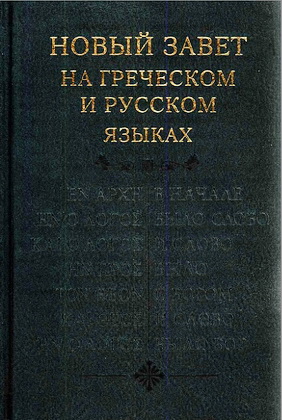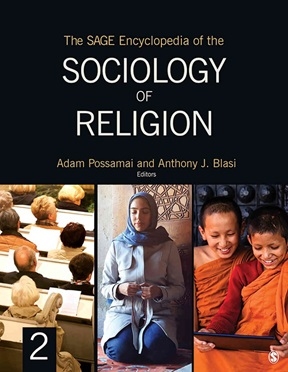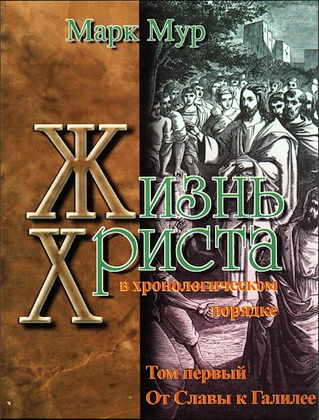
The SAGE Encyclopedia of the Sociology of Religion
The SAGE Encyclopedia of the Sociology of Religion
By Adam Possamai, Anthony J. Blasi (Editors). - 1st Edition. - Thousand Oaks, CA: SAGE Publications, Inc., 2020. – 1000 p.
ISBN-10: 1473942209
ISBN-13: 978-1473942202
Religion, understood as a Eurocentric concept, has been central to humanity since systematic and organised concerns about the non-visible and the afterlife started to develop. The sociology of religion, on the other hand, is more recent and started at the beginning of modernity with the late 19th- and early-20th-century works of the likes of Émile Durkheim, Karl Marx, Max Weber, Georg Simmel, and William E. B. DuBois. There were some precursors to this discipline going back to early 19th-century thinkers such as Alexis de Tocqueville and Henri de Saint-Simon, and even further back during the Middle Ages and away from Europe with Al-Biruni and Ibn-Khaldun.
The sociology of religion is foremost a social science. Consequently, it does not presuppose any theistic or theological commitments or, for that matter, the opposite of such. It takes religion as one institution among such others as the family, government, medicine, the military, or economy. An institution is a common response to a situation, experience, problem, or desideratum. As a common response, it involves many people in societies, but not necessarily all of them. It is often said that all societies have religions, but that does not mean that all people do have one. Consequently, one of the interesting aspects of religion is the degree to which individuals are involved in it, resulting in a continuum from not at all, to its being central in people’s lives. Another interesting aspect is the relationship between religion and other social institutions.
The sociology of religion figured importantly in the early development of the social scientific field. Auguste Comte saw religion as something to be replaced by sociology; consequently, he modelled the discipline along the lines of the religion he was familiar with in 19th-century France. Marx similarly saw a need to clear away ‘ideology’—intellectual creations that served interests other than human progress (as he understood it); he saw religion as an ideology that responded to the all-too-common human condition of deprivation. Durkheim saw religion as a system of beliefs and practices that supported the social solidarities of societies and believed understanding religion was essential to any coherent sociology. Weber, like the other founders already mentioned here, de-dogmatized Marx, in a sense, seeing that class and other kinds of social strata tended to make religious traditions into ideologies, but that religious belief systems also affected people’s social conduct and thereby continuously restructured societies. Again, one could not really have an adequate sociology without a sociology of religion. Simmel, a contemporary of Durkheim and Weber, described social structure in terms of forms: superordination and subordination, alliances, competition, inequality, secrecy, persistence of the group, and the like. Religious examples of these populated his major sociological treatise, Soziologie.
The early development of the sociology of religion was largely theoretical. A later development was empirical, especially quantitative. The ‘mainline’ Protestant denominations in the United States, aided for a time by Rockefeller funding following the First World War, created quantitative data collection and analysis techniques; these worked their way into American rural sociology largely because of the importance of religion in rural life. The studies by H. Paul Douglas—both urban and rural—come to mind. After the Second World War, Francophone Europe focused on persons rather than local churches and developed indices of people’s involvement in religious organizations, such as the studies by Gabriel LeBras. The flourishing of survey research about individuals’ religious beliefs and practices began when the late Charles Y. Glock, not yet having computers at hand, used sorting machines to process quantitative data, beginning with studies he conducted at Paul Lazarsfeld’s Bureau of Applied Social Research at Columbia University. Computers enabled the use of correlational and regression statistical analyses well into the careers of Glock’s student Rodney Stark, and of Andrew Greeley and his student Richard Schoenherr. It should be noted that the sociology of religion was at the very origin of contemporary survey research.
Even as the sociology of religion developed as part of, and at the forefront of, contemporary social science, it remained something of a backwater. Especially in the 1960s and 1970s, there were many more problems and issues to be studied that were regarded as more timely: urban riots, wars, revolutions, peace, sexual mores.… But then there were a host of new religions popping up, and an increasingly high-profile qualitative study of religious exotica emerged. And in the wake of a few sectarian suicides, the emergence of the New Christian Right in politics made news as well. And then political Islam came onto the scene. The founders of sociology had a point; religion was essential to what was going on in society. Or so it seemed.
* * *
Magic
Today, the term magic refers to a form of entertainment and also to cultic outlooks and conduct associated with New Age spirituality. Historically and cross-culturally, a diverse range of practices is identified as magical, and the role of magician has been attached to a variety of social status positions. Magical practices call upon extraneous powers, both natural and supernatural, through such means as ritual engagements (including hypnosis and trance), the application of empowered objects (potions and talismans), or recitations or incantations (blessings and spells). Magical practices include alchemy (transmutation of base to noble substance), mediumship (communication with the spirit world), necromancy (calling up and commanding spirits), shamanism (placating spirits), sorcery (influencing events through assistance of spirits or demons), and witchcraft (devilish enchantment). While this list is incomplete and the characterization of its elements is contestable, the practices designated as magical are widely regarded as associated not only in various ways with spirits, demons, or gods but also in service of mundane or practical ends rather than in generation of abstract meaning systems.
Scholarly discussion of magic is now extensive in the study of European history and in anthropology. Notable surveys of magic in ancient Greece and Rome, the European Middle Ages, and early modern England, among others, provide extensive case material. Influential anthropological studies include Marcel Mauss’s general argument concerning the totalized nature of magic, Bronislaw Malinowski’s pioneering functionalist account of magic, and the slightly later treatment by E. E. Evans-Pritchard of the function of magic-related beliefs. Classical sociology, on the other hand, is preoccupied with the distinction between magic and religion.
Émile Durkheim, in The Elementary Forms of the Religious Life, observes that distinctive beliefs and rites attach to both magic and religion and that the forces invoked by them are often the same. This does not mean, however, that for Durkheim, magic cannot be differentiated from religion. Religious beliefs and rites, according to Durkheim, are shared by a group; magic, however, does not unite individuals participating in society together. Organizations of magicians may form, but only for practitioners not for their clients. Because they do not generate moral community, ties between magicians and those who consult them are not durable. This difference is associated with another, according to Durkheim. Religious prohibitions derive from a notion of the sacred, and their transgressions operate in terms of the notion of sin; magic prohibitions, on the other hand, presuppose a secular idea of property. So while religious prohibitions are categorical imperatives, prohibitions associated with magic are utilitarian. Hence, Durkheim argues that magic pursues technical and utilitarian purposes, while religion pursues moral goals. Durkheim thus disagrees with the evolutionary thinking of James G. Frazer in the Golden Bough, and incidentally, as we shall see, with Max Weber, that religion develops out of a past of magical belief and practice. On the contrary, for Durkheim, magic is dependent on religion in its origins and form.
Weber regards magic as the primitive form of religion even though magic may be constrained, opposed, rejected, and ultimately displaced in the process of religious rationalization. Magic is understood by Weber to exist in at least three distinct forms, depending on how practitioners relate to it. In its historically earliest manifestation, magic has a practical purpose and in that sense is rational insofar as it follows rules of experience, even though a magically motivated action is not necessarily in accordance with objective means–end relations. Secondly, magic may be transformed from a direct manipulation of forces into a symbolic activity. Magic coerces the gods, religions worship them; as religious consciousness develops, then prayer and sacrifice displace magic. A third manifestation of magic in religion is aesthetic expression, in art and also in craft, even though the artisan’s modus operandi, according to Weber, is rational calculation.
As with Durkheim, Weber distinguishes magic from religion in terms of organization; priests are employees or functionaries operating in the interests of the organization’s members, whereas magicians are self-employed. Additionally, each draws on a different knowledge base, with priests possessing professional training in special knowledge, fixed doctrine, and vocational qualifications, while magicians exert their influence by virtue of personal gifts, what Weber calls charisma—even though a sorcerer may sometimes be very learned, while deep learning may not characterize working priests. The rational training and discipline of priests nevertheless contrast with the training of magicians, which draws on irrational means, aims at such things as rebirth, and proceeds in part, in Weber’s terms, as training in empirical practices. The crucial feature of the priesthood, then, according to Weber, is its specialization as a social group in a continuing maintenance of a cultic enterprise, identified with particular norms, spaces, and times and related to identifiable social groups. In those cases where the priesthood has failed to achieve independent class status, then, Weber holds, the rationalization of religious life is either fragmentary or absent. According to Weber’s Protestant Ethic argument, religious rationalization is fully achieved when ascetic Protestantism eliminated magic and the supernatural quest for salvation.
The classical sociological focus on the relationship between magic and religion is, it may be argued, misplaced and distorts the understanding of magic in two ways. The practical aspects of magic, typically associated with healing and other dimensions of well-being, connect it with empirical arts and proto-science as much as with religion. Furthermore, in the absence of the idea of a providential God as the creator and director of the natural universe, magical manipulations of nature are without necessary religious resonance, a matter of significance in understanding non-Western magic. Although historical writers continue to employ the generic term magic, sociologists today seldom use the word and focus on specific practices or doctrines treated in the more or less immediate context in which they appear.
Jack Barbalet
See also Malinowski, Bronislaw; Shamanism; Witchcraft
Further Readings
- Greenwood, S. (2009). Magic, Witchcraft and the otherworld: An Anthropology. London, UK: Berg.
- Kieckhefer, R. (2000). Magic in the Middle Ages. Cambridge, UK: Cambridge University Press.
- Styers, R. (2004). Making magic: Religion, magic, and science in the modern world. Oxford, UK: Oxford University Press.





Комментарии
Пока нет комментариев. Будьте первым!